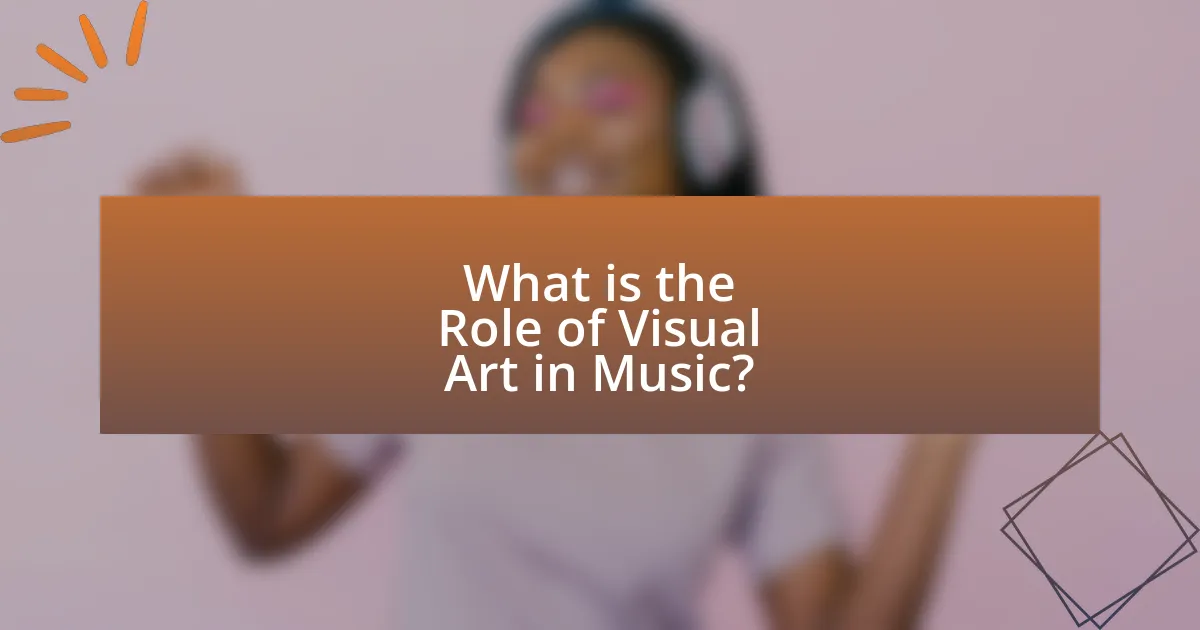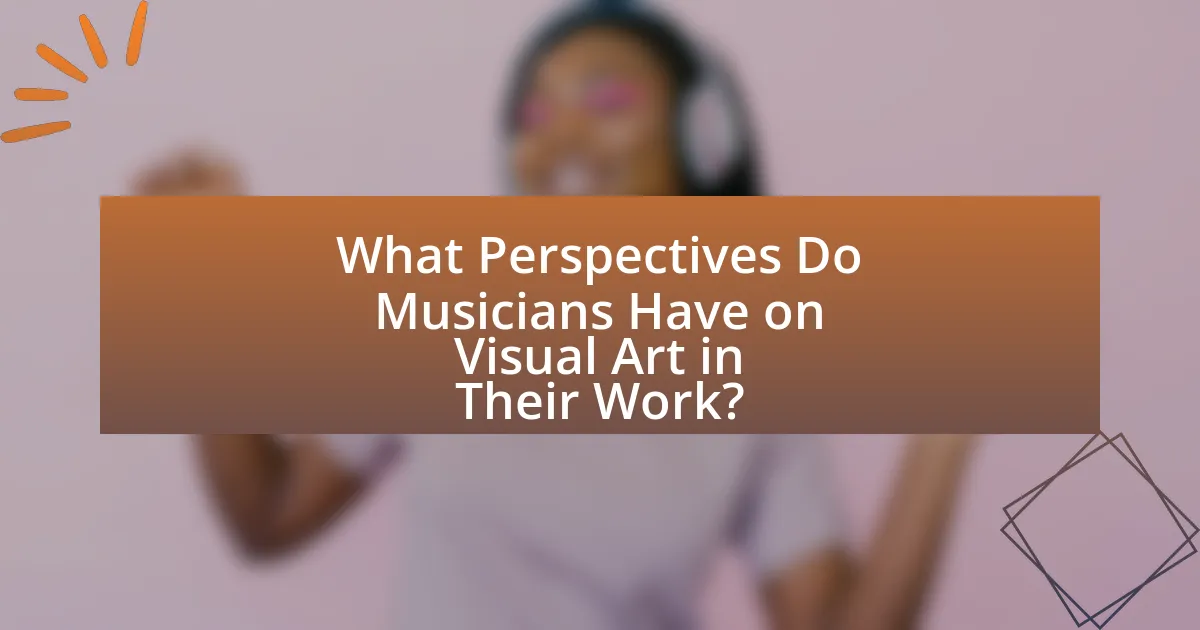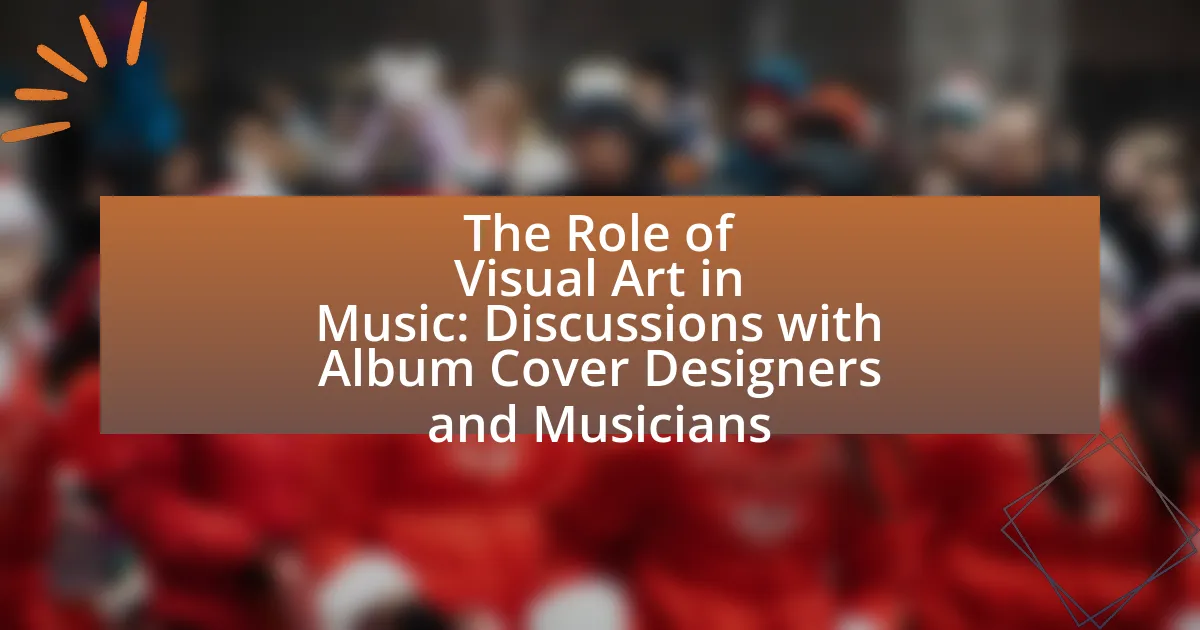The article examines the integral role of visual art in music, focusing on album cover design and its impact on artist branding and listener engagement. It highlights how visual elements such as color, composition, and imagery influence the perception of music, shaping emotional responses and enhancing the overall experience. The article also explores the collaborative processes between musicians and designers, the significance of album art in marketing, and the historical trends that have shaped this art form. Additionally, it discusses the challenges designers face and the best practices for effective collaboration, providing insights from both musicians and designers on the importance of visual storytelling in the music industry.

What is the Role of Visual Art in Music?
Visual art plays a crucial role in music by enhancing the overall experience and conveying the themes of musical works. Album covers, for instance, serve as visual representations of the music, often reflecting the artist’s vision and the emotional tone of the songs. Research indicates that visually appealing artwork can significantly influence consumer behavior, with studies showing that 75% of music listeners are drawn to albums based on their cover art. This connection between visual art and music not only aids in branding and marketing but also deepens the listener’s engagement with the music, creating a multi-sensory experience that enriches the artistic expression.
How does visual art influence the perception of music?
Visual art significantly influences the perception of music by shaping emotional responses and contextual interpretations. For instance, album covers often visually represent the themes and moods of the music, guiding listeners’ expectations and enhancing their overall experience. Research indicates that visual stimuli can evoke specific emotions that align with musical elements, as demonstrated in studies where participants reported heightened emotional engagement when music was paired with complementary visual art. This interplay between visual and auditory elements creates a multi-sensory experience that deepens the listener’s connection to the music.
What elements of visual art are most impactful in music?
Color, composition, and imagery are the most impactful elements of visual art in music. Color influences mood and emotional response, as seen in album covers that use specific palettes to evoke feelings; for example, warm colors can create a sense of energy, while cool colors may evoke calmness. Composition, including layout and balance, guides the viewer’s eye and can reflect the music’s structure or themes, as demonstrated in iconic album designs like The Beatles’ “Sgt. Pepper’s Lonely Hearts Club Band.” Imagery, whether abstract or representational, can convey the artist’s message or aesthetic, enhancing the listener’s connection to the music, as evidenced by the striking visuals of Pink Floyd’s “The Dark Side of the Moon.” These elements work together to create a cohesive artistic identity that resonates with audiences.
How do colors and imagery affect musical interpretation?
Colors and imagery significantly influence musical interpretation by evoking emotions and shaping listener perceptions. For instance, warm colors like red and orange can create feelings of excitement or passion, while cooler colors such as blue and green often evoke calmness or sadness. Research indicates that visual elements can enhance the emotional experience of music; a study published in the journal “Psychology of Music” by Bruner and O’Connell (2018) found that participants’ emotional responses to music were altered when paired with specific colors and images. This interplay between visual art and music underscores how colors and imagery can guide listeners’ interpretations and emotional connections to musical pieces.
Why is album cover design significant in the music industry?
Album cover design is significant in the music industry because it serves as a visual representation of the artist’s identity and the themes of the music. This visual element plays a crucial role in attracting potential listeners, as studies show that 90% of information transmitted to the brain is visual, making impactful artwork essential for marketing and branding. Furthermore, iconic album covers, such as The Beatles’ “Sgt. Pepper’s Lonely Hearts Club Band,” have become cultural symbols, demonstrating how effective design can enhance an album’s legacy and influence.
What historical trends have shaped album cover art?
Historical trends that have shaped album cover art include the rise of modernism in the 20th century, the influence of counterculture movements, and advancements in printing technology. Modernism introduced minimalist designs and abstract art, as seen in iconic covers like The Beatles’ “Revolver,” which emphasized artistic expression over commercial appeal. Counterculture movements of the 1960s and 1970s, particularly in rock music, led to vibrant, psychedelic artwork, exemplified by albums like Pink Floyd’s “The Dark Side of the Moon,” which reflected the era’s social changes. Additionally, advancements in printing technology allowed for more complex and colorful designs, enabling artists to experiment with various materials and formats, as demonstrated by the gatefold covers popularized in the vinyl era. These trends collectively transformed album cover art into a significant aspect of music marketing and cultural expression.
How do album covers contribute to an artist’s brand identity?
Album covers significantly contribute to an artist’s brand identity by visually encapsulating their musical style and persona. These covers serve as a primary visual representation, influencing audience perception and recognition. For instance, iconic album covers like The Beatles’ “Sgt. Pepper’s Lonely Hearts Club Band” not only reflect the band’s innovative sound but also establish a lasting cultural impact, reinforcing their identity as pioneers in music. Additionally, research indicates that consistent visual themes across album covers can enhance brand recall, as seen in artists like Taylor Swift, whose evolving yet cohesive aesthetic aligns with her musical evolution. This visual branding fosters a deeper emotional connection with fans, solidifying the artist’s identity in a competitive market.
What are the collaborative processes between musicians and designers?
Collaborative processes between musicians and designers involve a series of interactions that shape the visual representation of music. Musicians typically provide thematic concepts, emotional tones, and specific ideas for their projects, while designers translate these elements into visual formats such as album covers, promotional materials, and merchandise. This collaboration often includes brainstorming sessions, feedback loops, and iterative design processes, where both parties refine ideas based on artistic vision and market trends. For instance, the design of an album cover may reflect the genre and mood of the music, as seen in the collaboration between Pink Floyd and designer Storm Thorgerson, which resulted in iconic imagery that complements the band’s sound.
How do musicians select designers for their album covers?
Musicians select designers for their album covers based on a combination of artistic vision, previous work, and personal connections. They often review portfolios to assess a designer’s style and how it aligns with their music’s themes. For instance, artists may choose designers who have successfully created covers for similar genres, ensuring a visual representation that resonates with their audience. Additionally, recommendations from industry peers and past collaborations can influence their decision, as trust and familiarity play significant roles in the selection process.
What roles do feedback and revisions play in the design process?
Feedback and revisions are critical components of the design process, as they ensure that the final product aligns with the intended vision and meets the needs of the audience. Feedback provides designers with insights from stakeholders, allowing them to identify strengths and weaknesses in their work. Revisions, driven by this feedback, enable designers to refine their concepts, enhance visual communication, and improve overall effectiveness. For instance, a study by the Design Management Institute found that companies that prioritize design and incorporate iterative feedback processes outperform their competitors by 228% in terms of stock market performance. This demonstrates that effective feedback and revisions not only enhance design quality but also contribute to greater business success.

What Insights Can We Gain from Discussions with Album Cover Designers?
Discussions with album cover designers provide insights into the intersection of visual art and music, revealing how design influences audience perception and artist branding. Designers often articulate the creative process behind album artwork, emphasizing the importance of visual storytelling that complements the music’s themes. For instance, the iconic cover of Pink Floyd’s “The Dark Side of the Moon,” designed by Storm Thorgerson, illustrates how imagery can evoke emotional responses and enhance the listening experience. Additionally, these discussions highlight the collaborative nature of the music industry, where designers work closely with musicians to ensure that the visual representation aligns with the artist’s vision and message. This collaboration can lead to innovative designs that resonate with fans and contribute to the overall cultural impact of the music.
What challenges do designers face in creating album art?
Designers face several challenges in creating album art, including the need to balance artistic expression with commercial viability. They must ensure that the artwork resonates with the music’s themes while appealing to the target audience. Additionally, designers often work under tight deadlines, which can limit creative exploration. The challenge of collaborating with musicians, who may have differing visions, adds complexity to the design process. Furthermore, designers must navigate the technical constraints of various formats and platforms, ensuring that the artwork translates well across digital and physical media. These factors collectively impact the effectiveness and reception of the album art.
How do designers balance artistic vision with commercial demands?
Designers balance artistic vision with commercial demands by integrating creativity with market research and client feedback. They often start with a strong conceptual framework that reflects their artistic intent while simultaneously considering the target audience’s preferences and the brand’s identity. For instance, successful album cover designers frequently analyze trends in music genres and visual styles to ensure their designs resonate with consumers, thereby enhancing sales and visibility. This dual approach allows designers to maintain their unique artistic voice while fulfilling the commercial objectives of their clients, ultimately leading to designs that are both innovative and marketable.
What are common misconceptions about album cover design?
Common misconceptions about album cover design include the belief that it is solely about aesthetics and that it does not significantly impact music sales or artist branding. In reality, album covers serve as a crucial visual representation of the music, influencing consumer perception and emotional connection. Research indicates that a compelling album cover can increase sales by up to 30%, demonstrating its importance in marketing strategies. Additionally, many assume that album covers are created in isolation from the music; however, effective designs often reflect the themes and emotions of the songs, creating a cohesive artistic vision.
How do designers interpret the music when creating visuals?
Designers interpret music by analyzing its emotional tone, rhythm, and lyrical content to create visuals that resonate with the auditory experience. For instance, a fast-paced, upbeat song may inspire vibrant colors and dynamic shapes, while a melancholic ballad might lead to softer hues and more subdued imagery. This interpretation is often guided by the desire to evoke similar feelings in the viewer as those experienced by the listener. Research indicates that visual elements can significantly enhance the emotional impact of music, as seen in studies that demonstrate how color and form can influence perception and mood.
What techniques do designers use to convey musical themes visually?
Designers use techniques such as color symbolism, typography, imagery, and composition to convey musical themes visually. Color symbolism allows designers to evoke specific emotions associated with music genres; for example, dark colors may represent heavy metal, while bright colors often align with pop music. Typography plays a crucial role in reflecting the mood and style of the music, with bold fonts suggesting energy and elegance indicating sophistication. Imagery, including illustrations or photographs, visually narrates the music’s story or themes, while composition organizes these elements to create a cohesive visual experience. These techniques are essential in creating album covers that resonate with the audience and reflect the artist’s vision.
How do designers ensure their work resonates with the target audience?
Designers ensure their work resonates with the target audience by conducting thorough research to understand audience preferences and cultural contexts. This involves analyzing demographic data, trends, and feedback to create designs that align with the audience’s values and emotions. For instance, a study by the Design Management Institute found that companies that prioritize design outperform their competitors by 228% over ten years, highlighting the importance of audience-centric design. By integrating these insights into their creative process, designers can produce work that effectively communicates and connects with the intended audience.

What Perspectives Do Musicians Have on Visual Art in Their Work?
Musicians view visual art as an integral component of their work, often using it to enhance their musical identity and convey thematic elements. For instance, album covers serve not only as marketing tools but also as visual narratives that reflect the music’s mood and message. Research indicates that 70% of consumers make decisions about music based on album artwork, highlighting its significance in shaping listener perceptions. Additionally, musicians frequently collaborate with visual artists to create cohesive artistic expressions that resonate with their audience, demonstrating the symbiotic relationship between music and visual art.
How do musicians view the relationship between music and visual art?
Musicians often view the relationship between music and visual art as deeply interconnected, with each medium enhancing the other. Many musicians believe that visual art, such as album covers and music videos, serves to amplify the emotional and thematic elements of their music, creating a more immersive experience for the audience. For instance, iconic album covers like Pink Floyd’s “The Dark Side of the Moon,” designed by Storm Thorgerson, visually encapsulate the album’s themes, thereby enriching the listener’s understanding and appreciation of the music. This synergy between the two art forms is frequently discussed in interviews and collaborations, highlighting how visual aesthetics can influence musical identity and vice versa.
What role does visual art play in a musician’s creative process?
Visual art significantly influences a musician’s creative process by providing inspiration and enhancing emotional expression. Musicians often draw from visual elements to shape their sound, using imagery to evoke specific feelings or themes in their music. For instance, album cover designs can reflect the mood and style of the music, guiding the listener’s interpretation and experience. Research indicates that visual stimuli can activate different areas of the brain associated with creativity, suggesting that the interplay between visual art and music fosters innovative ideas and artistic development.
How do musicians feel about the impact of album art on their music’s success?
Musicians generally believe that album art significantly impacts their music’s success. Many artists assert that visually appealing and conceptually strong album covers can attract listeners and enhance the overall experience of their music. For instance, a study by the University of Southern California found that 67% of music consumers consider album art important when deciding to purchase or stream music. This indicates that musicians recognize the correlation between compelling visuals and audience engagement, ultimately influencing sales and streaming numbers.
What are the personal stories behind iconic album covers?
Iconic album covers often have deeply personal stories tied to their creation. For example, the cover of Pink Floyd’s “The Dark Side of the Moon” features a prism, symbolizing the band’s exploration of light and sound, which reflects their own struggles with mental health and the pressures of fame. Similarly, Nirvana’s “Nevermind” cover, depicting a baby swimming towards a dollar bill, was inspired by Kurt Cobain’s critique of capitalism and innocence lost, representing his personal views on society. The Beatles’ “Sgt. Pepper’s Lonely Hearts Club Band” cover showcases a collage of influential figures, reflecting the band’s desire to connect with their own influences and the cultural zeitgeist of the 1960s. Each of these covers encapsulates not only artistic vision but also the personal narratives and societal commentary of the artists involved.
How do musicians collaborate with designers to tell their stories visually?
Musicians collaborate with designers by sharing their artistic vision and narrative, which designers then translate into visual elements such as album covers, promotional materials, and merchandise. This collaboration often involves discussions about themes, emotions, and the overall message the musician wants to convey, allowing designers to create visuals that resonate with the music’s tone and style. For instance, the collaboration between musician Kanye West and designer Virgil Abloh resulted in iconic album artwork that reflects the themes of identity and culture present in West’s music. This synergy not only enhances the listener’s experience but also establishes a cohesive brand identity for the musician.
What memorable experiences have musicians had with album cover art?
Musicians have had numerous memorable experiences with album cover art, often viewing it as an extension of their artistic expression. For instance, The Beatles’ “Sgt. Pepper’s Lonely Hearts Club Band” cover, designed by Peter Blake and Jann Haworth, is celebrated for its vibrant collage of cultural icons, which not only defined the band’s image but also influenced the visual language of music. Additionally, Pink Floyd’s “The Dark Side of the Moon,” featuring a prism designed by Storm Thorgerson, has become iconic, symbolizing the band’s exploration of complex themes. These experiences highlight how album cover art can create lasting impressions and resonate with audiences, reinforcing the connection between music and visual storytelling.
What best practices can musicians follow when working with visual artists?
Musicians should establish clear communication and collaboration with visual artists to ensure a cohesive artistic vision. This involves discussing concepts, themes, and expectations upfront, which helps align both parties’ creative processes. Additionally, musicians should respect the artistic integrity of visual artists by allowing them creative freedom while providing necessary guidance. This balance fosters innovation and results in compelling visual representations of the music. Research indicates that successful collaborations often stem from mutual respect and understanding, as seen in projects like the iconic partnership between Pink Floyd and designer Storm Thorgerson, which produced memorable album covers that enhanced the band’s identity.
